Plant Summary
 Botanical Name: Gardenia jasminoides
Botanical Name: Gardenia jasminoides
Type: Flowering
Origin: Though growing wild in India, Japan, Southern China, Taiwan and Vietnam, cultivated Gardenias typically originate from China.
Height: Gardenia jasminoides can grow to heights ranging between 30 and 90 cm (1 to 3 ft).
Soil: This type of house plant prefers a potting mix that is lime free.
Light: Gardenias like bright, but indirect light. During the winter months, a little direct sunlight will not harm them.
Humidity: A wet pebble tray or a regular room humidifier will provide the humidity Gardenias love. During summer, misting is recommended, although care should be taken to mist only the foliage - Gardenia flowers should not be misted.
 Temperatures: Gardenia jasminoides thrives in normal room temperatures ranging around 16 to 24 degrees C (60 to 75 degrees F). Providing night temperatures at the lower end of the range and day temperatures reaching the top end will promote budding.
Temperatures: Gardenia jasminoides thrives in normal room temperatures ranging around 16 to 24 degrees C (60 to 75 degrees F). Providing night temperatures at the lower end of the range and day temperatures reaching the top end will promote budding.
Water: Throughout the growing season, the potting mix should be kept evenly moistened. Allowing the mix to dry a little between watering sessions and using a pot with drainage holes will prevent over-watering, which may lead to yellowing leaves. In winter, watering should be reduced slightly.
Fertiliser: Fed a diluted (50:50) liquid balanced fertiliser once a fortnight from spring through into late autumn. To prevent fertiliser burn, feeding should only take place while watering the plant.
Propagation: Gardenia jasminoides can be propagated by taking 8 cm (3") long cuttings of stem tips. Best cut in spring - or at the latest in early summer - the cut end should be dipped into hormone rooting powder, after which they need to be placed into moistened potting mix and covered to retain humidity. A plastic bag or cloche will be perfect for this purpose.
Description and Care Tips
 Also known as Cape Jasmine, Cape Jessamine or Common Gardenia, the evergreen Gardenia jasminoides is a flowering shrub belonging to the Rubiaceae family. Cultivated in China for around a thousand years, Gardenias are often planted in gardens within subtropical/ warm temperate climates, while being kept as house plants in cooler temperate regions.
Also known as Cape Jasmine, Cape Jessamine or Common Gardenia, the evergreen Gardenia jasminoides is a flowering shrub belonging to the Rubiaceae family. Cultivated in China for around a thousand years, Gardenias are often planted in gardens within subtropical/ warm temperate climates, while being kept as house plants in cooler temperate regions.
Since the plant was introduced to the gardens of England in the middle of the 18th Century, many different forms have been bred. Some forms are low growing, while others have particularly large, long lasting flowers.
What all of these forms have in common are the beautiful creamy white and heavily scented flowers that appear among the prominently veined, shiny dark green leaves and greyish bark during late spring and summer. The flowers are later followed by comparatively small oval fruit.
In its native habitats, this fruit is used to create a yellow dye for both food and clothing, and apparently, traditional Chinese medicine uses them in potions to treat fevers.
Often given as welcoming/ house warming gifts, Gardenias should be repotted - selecting a fairly small container will control the plant's overall size - and pruned in late winter to keep them in shape and promote blooming. Pruning should be done using a clean, sharp pruner to cut stems just above nodes (where branches/ leaves are attached to them) at a slight angle.
 Warm days followed by cooler nights (see above for ideal temperatures) and plenty of indirect, but bright light will trigger buds. Once the buds start appearing, the plant needs to be kept in a draft-free, well-lit area away from fire places or gas stoves (the fumes of natural gas can seriously harm this house plant).
Warm days followed by cooler nights (see above for ideal temperatures) and plenty of indirect, but bright light will trigger buds. Once the buds start appearing, the plant needs to be kept in a draft-free, well-lit area away from fire places or gas stoves (the fumes of natural gas can seriously harm this house plant).
Regularly checking the soil will prevent it from drying out - flowering Gardenias are extremely thirsty, and dry soil will result in the buds dropping off. It is, however, vital not to get the soil too soggy, as this may not only cause the leaves to turn yellow, but may also result in dropping buds.
It is important to avoid using very hard water to water Gardenias, as this will make it difficult for the plant to absorb the nutrients it requires. If using hard water is unavoidable, adding a little lemon juice or vinegar to it will lower the water's pH and make life a little easier for the plant.
If placed outside during the summer, Gardenias should be kept in a shaded position and must be returned indoors if temperatures threaten to drop below 16 degrees C (60 degrees F). Well looked after, happy Gardenias may even flower a second time during the autumn months.
While keeping these gorgeous little shrubs happy seems to require a lot of effort, the magnificent flowers and intoxicating fragrance are well worth it.




 This list includes a selection of common, not quite so common and unusual house plants beginning with the letter 'F'. If the name of a plant is not known - sometimes well meaning friends remove details before giving a plant as a present because the price happens to be on the label - it may be possible to first of all identify it by taking a peek at the images shown in the
This list includes a selection of common, not quite so common and unusual house plants beginning with the letter 'F'. If the name of a plant is not known - sometimes well meaning friends remove details before giving a plant as a present because the price happens to be on the label - it may be possible to first of all identify it by taking a peek at the images shown in the  Botanical Name: Fuchsia x hybrida, or Fuchsia hybrids
Botanical Name: Fuchsia x hybrida, or Fuchsia hybrids  Humidity: Fuchsia hybrids prefer moderate levels of humidity, so it may become necessary to
Humidity: Fuchsia hybrids prefer moderate levels of humidity, so it may become necessary to  With adequate care, Fuchsia hybrids will provide a dazzling display of magnificent blooms from spring through into late autumn for many years. Fuchsia blooms are spectacular, with pistils and stamens extending from bell-shaped single, double or semi-double petals toped by four flared sepals, which are often in colours contrasting with those of the petals.
With adequate care, Fuchsia hybrids will provide a dazzling display of magnificent blooms from spring through into late autumn for many years. Fuchsia blooms are spectacular, with pistils and stamens extending from bell-shaped single, double or semi-double petals toped by four flared sepals, which are often in colours contrasting with those of the petals.  Pinching out the growing tips during spring (or, at the latest, in early summer) will encourage the Fuchsia to branch out, giving it a much fuller appearance. The pinched out tips can, by the way, be used for propagation, as they will root easily. Spring is also a good time to prune this plant, using sharp pruners to cut stems cleanly just above leaf axils and at an angle of 45 degrees. This will help to give the plant an attractive shape and encourage new, vigorous growth. Naturally, it is important not to remove any flower buds during pruning.
Pinching out the growing tips during spring (or, at the latest, in early summer) will encourage the Fuchsia to branch out, giving it a much fuller appearance. The pinched out tips can, by the way, be used for propagation, as they will root easily. Spring is also a good time to prune this plant, using sharp pruners to cut stems cleanly just above leaf axils and at an angle of 45 degrees. This will help to give the plant an attractive shape and encourage new, vigorous growth. Naturally, it is important not to remove any flower buds during pruning. 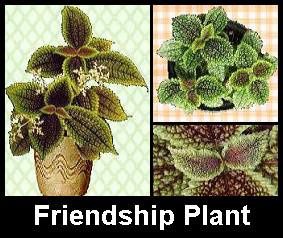 Botanical Name: Pilea involucrata
Botanical Name: Pilea involucrata  Water: While the soil can be kept a little drier during the winter, it should be kept evenly moistened from early spring until late autumn.
Water: While the soil can be kept a little drier during the winter, it should be kept evenly moistened from early spring until late autumn.  The ovate leaves of the Friendship Plant grow in opposing pairs and may be smooth, with silvery veins (like in the 'Norfolk' variety) or quilted and apple-green with veins that are deep bronze in colour, like those of the popular 'Moon Valley' variety. This latter variety is also more upright than the species, which is effectively a trailing plant, and the undersides of its deeply textured, toothed leaves are dark-red. In spring, clusters of pinkish-green, tiny flowers may emerge, but these flowers are generally considered to be insignificant in comparison to the gorgeous showy foliage.
The ovate leaves of the Friendship Plant grow in opposing pairs and may be smooth, with silvery veins (like in the 'Norfolk' variety) or quilted and apple-green with veins that are deep bronze in colour, like those of the popular 'Moon Valley' variety. This latter variety is also more upright than the species, which is effectively a trailing plant, and the undersides of its deeply textured, toothed leaves are dark-red. In spring, clusters of pinkish-green, tiny flowers may emerge, but these flowers are generally considered to be insignificant in comparison to the gorgeous showy foliage.  Soggy or dry soil may also cause the leaves to drop off, so keeping the balance just right when watering Friendship Plants is essential. Given adequate humidity levels, warmth and careful watering, Pilea involucrata will reward its owner with beautiful foliage for many years to come. Keeping the plant away from direct sunlight (as this will scorch the leaves), drafts and heat vents (which will dry the surrounding air too much) will also help to keep this lovely house plant a joy to behold.
Soggy or dry soil may also cause the leaves to drop off, so keeping the balance just right when watering Friendship Plants is essential. Given adequate humidity levels, warmth and careful watering, Pilea involucrata will reward its owner with beautiful foliage for many years to come. Keeping the plant away from direct sunlight (as this will scorch the leaves), drafts and heat vents (which will dry the surrounding air too much) will also help to keep this lovely house plant a joy to behold. 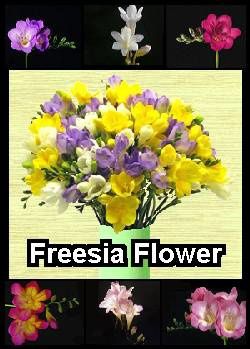 Botanical Name: Freesia hybrids
Botanical Name: Freesia hybrids  Water: The soil should be kept slightly moistened. Over-watering can cause corms to rot, and should be avoided.
Water: The soil should be kept slightly moistened. Over-watering can cause corms to rot, and should be avoided.  The corms of Freesia Flowers are easily forced into blooming, and should be planted from late summer into early autumn for an abundance of blooms in winter or early spring. To force Freesia Flowers, a fairly shallow container - which should have a minimum depth of 7 cm (3 in) - should be filled loosely with a suitable potting mix.
The corms of Freesia Flowers are easily forced into blooming, and should be planted from late summer into early autumn for an abundance of blooms in winter or early spring. To force Freesia Flowers, a fairly shallow container - which should have a minimum depth of 7 cm (3 in) - should be filled loosely with a suitable potting mix.  The pot then needs to be moved to a warm - 27 degrees C (80 degrees F) - and bright spot for around 8 weeks, keeping the mix barely moistened throughout. Once the emerging shoots reach a height of around 5 cm (2 in), the pot should be moved to a cooler - 16 to 18 degrees C (60 to 65 degrees F) - bright location until buds begin to form. To ensure even growth, the pot needs to be turned every two days or so. Keeping Freesia Flowers in a bright spot - but out of direct sunlight - when in full bloom will help to prolong the blooming period.
The pot then needs to be moved to a warm - 27 degrees C (80 degrees F) - and bright spot for around 8 weeks, keeping the mix barely moistened throughout. Once the emerging shoots reach a height of around 5 cm (2 in), the pot should be moved to a cooler - 16 to 18 degrees C (60 to 65 degrees F) - bright location until buds begin to form. To ensure even growth, the pot needs to be turned every two days or so. Keeping Freesia Flowers in a bright spot - but out of direct sunlight - when in full bloom will help to prolong the blooming period. 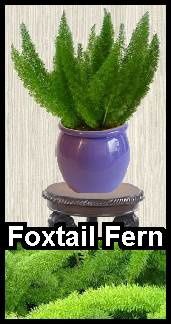 Botanical Name: Asparagus densiflorus 'Myers'
Botanical Name: Asparagus densiflorus 'Myers'  Fertiliser: From spring into autumn, Asparagus densiflorus 'Myers' should be fed once a month with a diluted (50:50) balanced fertiliser.
Fertiliser: From spring into autumn, Asparagus densiflorus 'Myers' should be fed once a month with a diluted (50:50) balanced fertiliser.  This house plant likes dappled sunlight, and too much sunlight may not only scorch the leaflets, it may also cause them to drop, as will dry soil. Although Asparagus densiflorus 'Myers' will tolerate occasional short drought periods, it will grow best when watered well, especially during active growing periods. It is, however, vital not to over-water Foxtail Ferns, as the thick roots store water and soggy soil will inevitably lead to root rot.
This house plant likes dappled sunlight, and too much sunlight may not only scorch the leaflets, it may also cause them to drop, as will dry soil. Although Asparagus densiflorus 'Myers' will tolerate occasional short drought periods, it will grow best when watered well, especially during active growing periods. It is, however, vital not to over-water Foxtail Ferns, as the thick roots store water and soggy soil will inevitably lead to root rot.  Botanical Name: Abutilon hybrids; Abutilon hybridum
Botanical Name: Abutilon hybrids; Abutilon hybridum  Water: Watering thoroughly should be followed by allowing the top 2.5 cm (1 in) of the potting mix to dry before watering again. While the soil needs to be kept evenly moistened, it should not be allowed to become soggy, as this will invite root rot.
Water: Watering thoroughly should be followed by allowing the top 2.5 cm (1 in) of the potting mix to dry before watering again. While the soil needs to be kept evenly moistened, it should not be allowed to become soggy, as this will invite root rot.  Available in a plethora of varieties (the image above show just a small selection of possibilities), the Flowering Maple features large, bell-shaped flowers, which will more or less cover the plant from spring right through into autumn.
Available in a plethora of varieties (the image above show just a small selection of possibilities), the Flowering Maple features large, bell-shaped flowers, which will more or less cover the plant from spring right through into autumn.  Spring is also the best time to propagate and repot Flowering Maples. As this house plant will bloom better when its roots are slightly pot-bound, repotting should only be done when necessary, and the new container should not be more than one size larger than the previous one.
Spring is also the best time to propagate and repot Flowering Maples. As this house plant will bloom better when its roots are slightly pot-bound, repotting should only be done when necessary, and the new container should not be more than one size larger than the previous one.  Botanical Name: Chrysanthemum morifolium; Chrysanthemum x morifolium
Botanical Name: Chrysanthemum morifolium; Chrysanthemum x morifolium  Temperatures: To prolong blooming, plants are best kept in temperatures ranging between 13 and 18 degrees C (55 to 65 degrees F).
Temperatures: To prolong blooming, plants are best kept in temperatures ranging between 13 and 18 degrees C (55 to 65 degrees F).  Originally golden yellow (hence its name Chrysanthemum, which essentially means Golden Flower), this plant is now available in a plethora of colours, including white and off-white; pink, red, and burgundy; yellow, bronze, lavender and purple.
Originally golden yellow (hence its name Chrysanthemum, which essentially means Golden Flower), this plant is now available in a plethora of colours, including white and off-white; pink, red, and burgundy; yellow, bronze, lavender and purple.  Pinching growing tips out every two to three weeks, starting when new spring growth has reached 10 to 15 cm (4 to 6 in) and ending in early summer, will result in the plant becoming bushier and producing more flower buds. Deadheading spent flowers will also encourage prolonged blooming.
Pinching growing tips out every two to three weeks, starting when new spring growth has reached 10 to 15 cm (4 to 6 in) and ending in early summer, will result in the plant becoming bushier and producing more flower buds. Deadheading spent flowers will also encourage prolonged blooming. 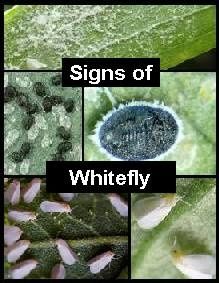 Clouds of adults rising during watering, or when moving the plant, as well as circles of eggs and/ or scale-like nymphs, which are easily spotted underneath leaves and on stems, are sure signs of whitefly infestations. Black areas caused by sooty mould attracted by the honeydew secreted by both adults and nymphs; slow/ stunted growth and wilting/ dropping foliage also indicate infestations.
Clouds of adults rising during watering, or when moving the plant, as well as circles of eggs and/ or scale-like nymphs, which are easily spotted underneath leaves and on stems, are sure signs of whitefly infestations. Black areas caused by sooty mould attracted by the honeydew secreted by both adults and nymphs; slow/ stunted growth and wilting/ dropping foliage also indicate infestations. Also known as storm flies, thunder blights, thunder bugs or thunder flies, thrips have a slender, cigar-shaped body typically ranging from 0.5 to 1 mm (0.02 to 0.04 in) in length, although predatory thrips can grow to lengths of 14 mm (0.55 in).
Also known as storm flies, thunder blights, thunder bugs or thunder flies, thrips have a slender, cigar-shaped body typically ranging from 0.5 to 1 mm (0.02 to 0.04 in) in length, although predatory thrips can grow to lengths of 14 mm (0.55 in).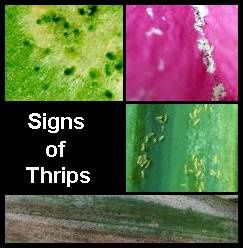 Because thrips rasp into flower petals and leaves to get at the sap, leaves and petals often appear distorted and feature visible scars. Thrips often also leave visible dark spots on flower petals and silvery streaks on foliage. In addition, it may be possible to detect the movement of congregations of larvae on the soil.
Because thrips rasp into flower petals and leaves to get at the sap, leaves and petals often appear distorted and feature visible scars. Thrips often also leave visible dark spots on flower petals and silvery streaks on foliage. In addition, it may be possible to detect the movement of congregations of larvae on the soil.